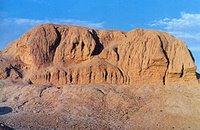Sialk Tappeh (Tappeye Sialk)

The richest archaeological site in central Iran is the mound of the Tappeh-ye Sialk which is located close to Kashan. This site was excavated by Ghirshman in the 1930s. The excavations revealed that the site is more than 7000 years old. Apparantly the Indo-European Aryans or Iranians arrived on the plateau during the second millennium BC, and it is at Tappeh Sialk that the remains of their most ancient dwellings have been found. The rich had jewels made of silver, and the poor of bronze or iron. Probably, one of the most interesting findings are inscribed clay tablets dating back to the late 3rd and early 2nd millennium BCE. The site has revealed a vast number and variety of pottery and domestic implements of clay, stone and bone from as early as the 4th millennium BC, and is believed to have been first settled in the 5th millennium or earlier. It appears to have been sacked and deserted in about the 8th century BC. You can still see the outline of various mud-brick buildings and a large number of potsherds embedded throughout the two mounds.
There are also some records showing immigrants and conquerors passing through this region and settling near Bagh-e Fin.
The artifacts uncovered reside in the Louvre Museum in Paris and the archaeological museum in Tehran. There is not much to do or see there today unless you are an archaeologist.
Ceramic jars from Sialk tappeh:
http://www.art-arena.com/Iran/jar.jpg
http://home.btconnect.com/CAIS/Images2/p060.jpg
Picture of Sialk Tappeh:
http://www.bestirantravel.com/images/sights/kashan/sialktapeh.jpg
http://www.art-arena.com/Iran/jar.jpg
http://home.btconnect.com/CAIS/Images2/p060.jpg
Picture of Sialk Tappeh:
http://www.bestirantravel.com/images/sights/kashan/sialktapeh.jpg


<< Home